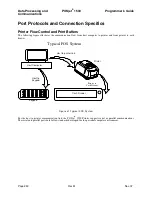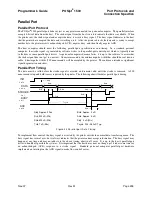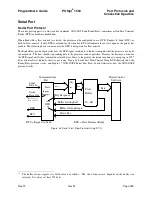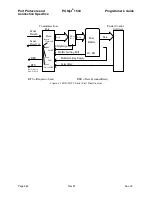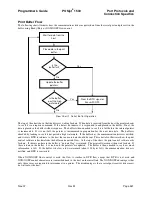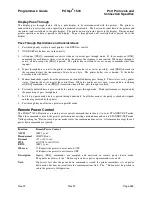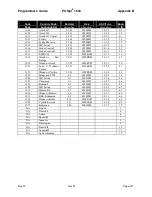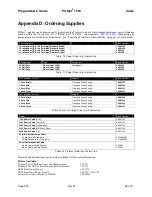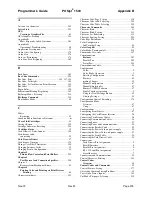
Programmer's Guide
POSjet
®
1500
Port Protocols and
Connection Specifics
Nov-07
Rev M
Page 263
Printer Buffer Size
The size of the POSjet
®
1500 buffer is configurable, which allows an application to control the information flow and
determine how much the buffer will process before being prompted to hold. The buffer size can be set from 256 to
6144 bytes (not including the 64-character high-speed buffer). The smaller the buffer, the tighter the control will be.
It is up to the developer to select the optimal buffer size for an application.
Serial Mode Plug and Play
Microsoft has defined a Plug and Play (PnP) protocol to identify devices on serial links. The enumeration process is
designed to find and automatically configure a device driver for the printer. It is done by toggling the control lines
in a specific sequence that is recognized by the printer. The peripheral then responds such that Windows can
identify the device.
To allow the printer to look for and respond to the sequence, EISA PnP must be enabled. When enabled in serial
mode, the flow control is forced to Request to Send (RTS) with Data Terminal Ready (DTR) static.
Using DSR
Windows uses the host’s Data Set Ready (DSR) line (the printer’s DTR line) on the serial port to determine whether
a device is attached to the port. When Windows is booted (or does PnP), the system sets the host’s DTR and RTS to
zero and waits approximately 200 milliseconds. It then sets the DTR to one, and waits another 200 milliseconds.
After 200 milliseconds, the system checks to see whether the DSR line is high. This indicates that a serial device is
attached to the serial port. The system responds by setting RTS high and waits to receive the device identification
string.
In some devices, such as the serial mouse, the DSR line can be held high by tying it directly to the DTR line. When
the mouse is connected to the serial port on the personal computer, the power supplied through the DTR line also
raises DSR high.
For Plug and Play compatibility, RTS flow control is used at the printer because DSR must stay high as long as the
device is attached to the serial port.
Serial Device Identification
The serial device must report its identification to the system using an identification string at 1200 baud. The
identification string consists of 18 fields that identify the device, class of the device, and other compatible devices.
Only five of the fields are required by all serial devices; all others are optional. The identification string used by the
POSjet
®
1500 printer follows.
0,1
PnP Rev
028H
Start of ASCII response
'IPR0210'
Unique ID (IPR plus revision level)
\PRINTER
Printer
\S1500 PcOS
Model
\SC:9600,N,8,1
Serial Configuration: Baud, Parity, Bits, Stop Bits
xxH
Check-sum
029H
End PnP
Note 1 The model field may be altered to generate PnP ID’s other than “S1500 PcOS” by special order.
When the identification is complete, the printer returns to the baud rate specified in the
configuration.
Summary of Contents for POSJET 1500
Page 1: ...PROGRAMMER S GUIDE POSjet 1500 PN 20 03398 Rev M Nov 2007...
Page 14: ......


